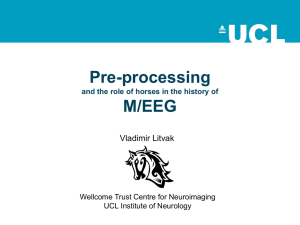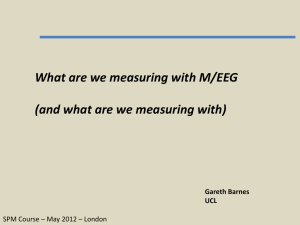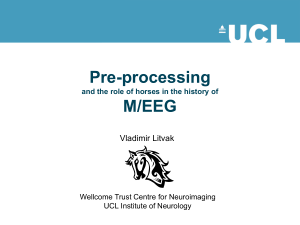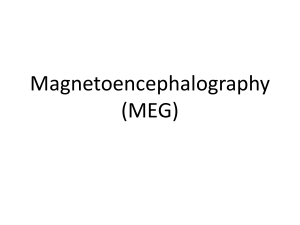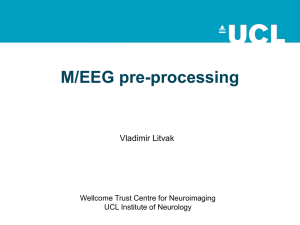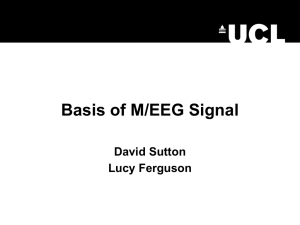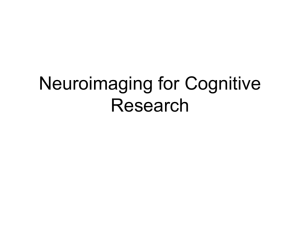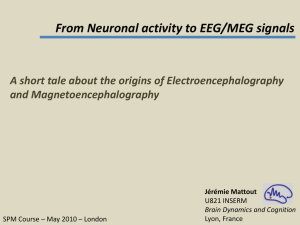Application of MEG in Neuroscience
advertisement
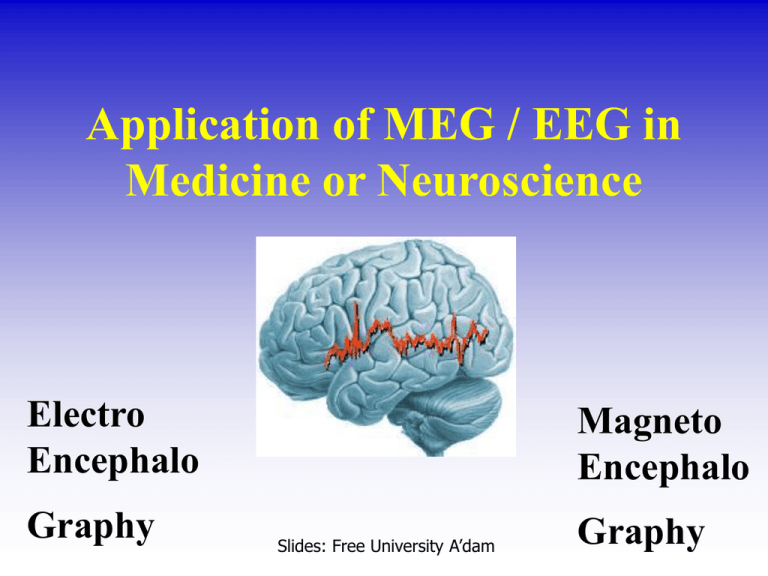
Application of MEG / EEG in Medicine or Neuroscience Electro Encephalo Graphy Magneto Encephalo Slides: Free University A’dam Graphy Application of MEG/EEG in Medicine or Neuroscience • • • • Introduction to EEG & MEG Instrumentation Analysis Examples – Magnetic Source Imaging – Localizing Rhytmic Activity A nervecell consists of a soma with input dendrites. On both synapses project as little pedicles. The axon is the output. Conduction speed is greatly improoved by the nodes of Renvier in the myelin sheeth. Synapses: At the synaptic cleft little follicles of neurotransmitter are released Nerve cell types A peripheral nerve bundle Fysiological basis of EEG and MEG • Transmembrane current • Intracellular current • Extracellular current Example of an EEG of a Petit Mal epileptic seizure, showing characteristic 3 Hz spike/wave complexes. The surface potential established by intracranial neural activity decresases with distance from the source. For dipolar sources, the potential falls as a function of the square of the distance. EEG measures the potential differences between two recording sites. Action potentials are associated with a leading depolarization front and a trailing repolarizing front. The associated current configuration is quadrupolar, and at a distance, the electrical field generated by each of the opposing current components mostly cancel each other. Introduction EEG EEG measures the potential difference on the skin surface due to the backflowing current at the surface. + + - Introduction to MEG • MEG records the gradient of the Magnetic Induction d B( x , t ) dx The Magnetic Induction results from electrical currents Introduction to MEG Electrical current in the brain •spatial components •transmembrane current •intra-cellulair current •extra-cellulair current •temporal components •activation of synapses •spiking activity EEG EEG “without” skull MEG “without” skull MEG How the EEG is recorded • Bipolar or Monopolar derivation – a-b; b-c; c-d; d-e; etc. – a-ref; b-ref; c-ref; d-ref; etc. • Clinical routine: 10-20 system with 21 electrodes • Recording problems: – – – – Skin resistance & skin capacitance Mechanical DC recording noise from bad grounding Modern EEG equipment • • • • • up to 256 leads small and portable fully digitized battery operated cheap Temporal aspects of MEG & EEG • Normal power spectrum of ongoing activity shows 1/f behaviour plus alpha band activity • Changes in ongoing signals can be induced by sensory stimulation: ERF: Event Related Fields, ERP: Event Related Potentials • ERF and ERP are significantly smaller than ongoing signals. Maximal SNR ~ 1:5; thus averaging necessary Eventrelated potentials need averaging. Each component in the waveform is thought to have a characteristic neural origin. Oscillatory dynamics • Event related desynchronization of the alpha, mu and tau rhythms occurs upon events that require processing of many stimulus aspects or recall (Pfurtscheller, 89) • Event related synchronization occurs in the gamma band upon similar “global” stimuli (Freeman, 76) • Many pathological conditions are associated with increased ongoing, mostly slow, rhythmical activity • During maturation oscillatory activity increases in frequency and decreases in amplitude • Sleep stages are characterized by different rhythms Oscillatory Rhythms in EEG/MEG • • • • • • • Alpha Beta Gamma Delta Theta Mu Tau EEG/MEG EEG/MEG EEG/MEG MEG/EEG EEG/MEG MEG/EEG MEG 8-13 Hz 18-30 Hz 40+ Hz 0-4 Hz 4-8 Hz 10-14 Hz 12-16 Hz Occipital Central Frontal The mu rhythm is maximal in a centralfrontal derivation. It is unreactive to eye opening and closing, but highly reactive to movements, such as making a fist. Repetitive triphasic complexes are a characteristic finding in the EEG of patients with progressive Creutzman-Jacob disease. Brain topology mapping: color coding of potential field Introduction to MEG • MEG has better spatial resolution than EEG • MEG is reference free • MEG has much better temporal resolution than fMRI, PET or SPECT but: magnetic signals from the brain are very small and MEG systems therefore difficult and expensive Every current induces a magnetic field Time-varying neuromagnetic signals induce an electrical current in the wire loops of the detection coil. For the axial gradiometer the upper and lower coil are wound in the opposite direction. The amount of current induced in the system therefore reflects the spatial gradient of the neuromagnetic field. Signal Amplitudes of Biomagnetism and environmental (in Tesla) • 100 mT Earth Field • 10mT • 1mT • 10-1000 nT Urban Noise • 10 nT VW beagle at 50m • 1 nT • 100 pT screwdriver at 5m • 10 pT • 1 pT CMOS IC op 2m • 100 fT diode op 1m • 10 fT • 1 fT noise-level Squids • 1 nT lung particles • • • • • • 100 pT heart 50 pT muscle 20 pT foetal heart 10 pT MRG 1 pT alpha rhythm 20-100 fT Evoked Fields Noise sources • • • • • • • • electromotors elevators power supplies cars trains MRI mechanical stimulus artefacts metal implants dental fillings bra’s piercings tattoos hair dyes • • • • ECG respiration eye movements “ongoing brain signal” Noise elimination • Shielding (MSR) 100.000x • Gradient formation (hardware or software) 1000x • Active compensation 0.1x-1000x • Adaptive filtering 100x Problems: costs introduction of high frequency noise decreased sensitivity How is the MEG recorded? • changed flux through pick-up coil => current through inputcoil • induction => flux over SQUID • Josephson junctions yield a potential • This potential is cancelled by feedback current through the feedback coil • The amplitude of the feedback signal is a measure of the flux at the pick-up coil. The 150 channel MEG system at the KNAW MEG/EEG Center at the Free University of Amsterdam (dr. B. van Dijk, director) Present System Hardware • • • • • 150 radial gradiometers; 5 cm baseline 29 field and gradient reference channels 72 EEG channels 16 ADC channels 32 digital channels (I/O) SQUID gradiometer SQUID array A Faraday shielding cage is necessary to prevent interferences with external Sources. Analysis EEG & MEG “Can we calculate the current sources in the brain from the measurements?” • Forward solution – given the electrical current density – given the form, susceptibility and conductance of the different tissues of the head • Calculate the magnetic induction or the electric field at the location of the sensors. Analysis EEG & MEG • Inverse solution: – given the magnetic induction/electric potential – assume a volume conductivity model • calculate the electrical current density Fysical basis EEG & MEG • Macroscopic Maxwell equations (linear; relations between D,H,B,E,j,s) • Material properties (conductivity, polarizability, susceptibility) • Quasi static approximation (time derivatives can be neglected) • Assume that material properties are homogeneous at the location of the sources Fysical basis EEG & MEG • Two decoupled expressions for the electrical potential: . . ji and for the magnetic induction: 1 1 B 1 • There are both in the electrical as in the magnetic case sources that do NOT lead to a macroscopic field. So there exist no unique inverse solutions. ji Analysis of EEG & MEG • “SILENT SOURCES”: Many electric current density distributions yield a magnetic induction field or a potential field that is identically zero outside the scalp. • As a result the inverse problem is only solvable by making assumptions about both volume conductor and electric current sources • • • • • infinite medium sphere sphere shells revolution ellipsoïds, with shells “realistic” models boundary elements finite elements MRI or other head-form description necessary Numerical Analytic Volume conductors stationary dipole co-registered to MR Visual colour reversal Picture Naming vs. Picture Recognition AbnormalLowFrequencyMagneticActivity 2 pT .25 s ALFMA Sleep spindles EEG and MEG LC LF LO LP LT RC RF RO RP RT EEG 3 pT, 130 uV 1 sec. Sleep spindles
